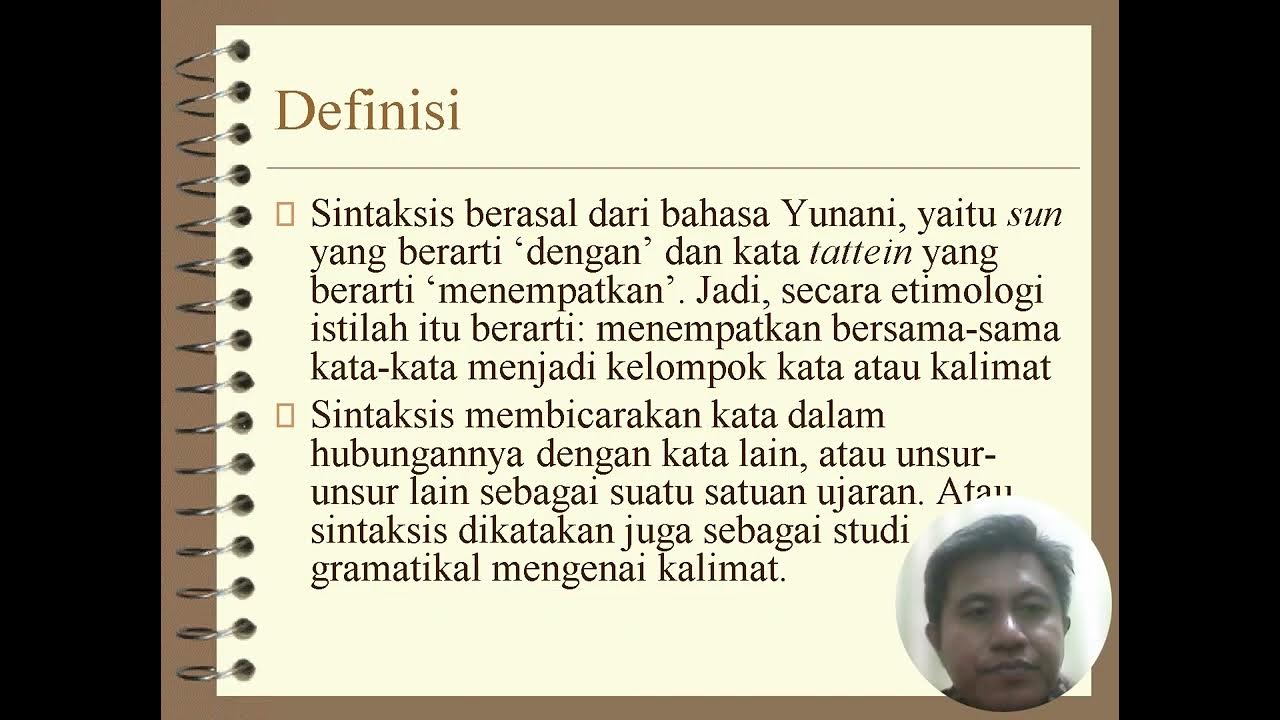FORM AND FUNCTION
Summary
TLDRThis video explains core concepts of syntax, focusing on sentence structure and the relationship between form and function. It covers different types of sentence constructions, such as **kopula** and **non-kopula**, active and passive voice, as well as subject-predicate-object relationships. The presentation introduces various syntactic elements, including word categories (noun, verb, adjective) and constituents. Key concepts like modifiers, head words, and sentence analysis are also discussed. The video includes practical exercises for identifying sentence functions, aimed at improving linguistic understanding and syntactic analysis.
Takeaways
- 😀 **Form vs Function**: The script explains the difference between **form** (word categories such as nouns, verbs, adjectives) and **function** (roles like subject, predicate, object) in sentence structure.
- 😀 **Syntax Basics**: Syntax involves learning sentence structure by understanding **word categories** (form) and **their roles** (function) to build meaningful sentences.
- 😀 **Understanding Constructions**: The script discusses sentence **constructions** like **copula** (linking verbs) and **non-copula** constructions, which are crucial in forming sentences without a main action verb.
- 😀 **Syntactic Units**: Syntax structures break down into **words**, **phrases**, and **clauses**. The smallest unit is a word, while the largest is a complete sentence.
- 😀 **Modifiers and Heads**: Sentences often include **modifiers** that provide additional detail, but their placement and relationship to the **head** (core word) of a phrase are key to sentence clarity.
- 😀 **Word Categories**: Understanding **word categories** (noun, verb, adjective, adverb, etc.) is essential for analyzing and constructing sentences accurately.
- 😀 **Subject, Predicate, Object**: The script explains how sentences typically follow the structure of **subject**, **predicate**, and **object**, with each serving a unique role.
- 😀 **Tree Diagrams in Syntax**: Tree diagrams are useful for breaking down sentences into their components, such as words, phrases, and clauses, helping to visualize their structure.
- 😀 **Types of Sentence Constructions**: There are different **sentence constructions** like **declarative** (statements) and **interrogative** (questions). They can also be **active** or **passive**.
- 😀 **Practical Exercises**: The script emphasizes practice with exercises to help students identify different constructions and their components (such as subject, verb, object, etc.) in various sentence examples.
Q & A
What is the main focus of the lesson discussed in the transcript?
-The main focus of the lesson is on the concepts of form and function in sentence construction, specifically in understanding syntax and sentence types, such as declarative, interrogative, active/passive constructions, and copula vs non-copula constructions.
What are the key components of a sentence discussed in the lesson?
-The key components of a sentence discussed include constituents, which are parts of the sentence such as words, phrases, or clauses, and the form and function of these components, including subjects, predicates, objects, and modifiers.
What is the difference between form and function in sentence construction?
-Form refers to the grammatical elements that make up a sentence, such as nouns, verbs, adjectives, etc., while function refers to the role these elements play in the sentence, such as subject, predicate, or object.
What is the significance of copula constructions in syntax?
-Copula constructions involve linking verbs (e.g., 'is', 'are') that connect the subject to a complement, helping to indicate identity or characteristics of the subject. For example, in 'She is a teacher,' 'is' is the copula linking the subject to the complement.
Can you explain the difference between active and passive voice in sentences?
-In active voice, the subject of the sentence performs the action, e.g., 'The cat chased the mouse.' In passive voice, the object of the action becomes the subject, and the doer of the action may be omitted or included, e.g., 'The mouse was chased by the cat.'
What does it mean for a sentence to have a double object construction?
-A sentence with a double object construction involves a verb that requires two objects: a direct object (the recipient of the action) and an indirect object (the entity to which the action is directed). For example, in 'She gave him a gift,' 'him' is the indirect object, and 'a gift' is the direct object.
What is the role of modifiers in sentence structure?
-Modifiers are words, phrases, or clauses that add more detail or description to the core elements of a sentence, such as the subject, verb, or object. They help clarify or specify information, like in 'The beautiful girl was dreaming for a chocolate watch.'
What is the difference between declarative and interrogative sentences?
-Declarative sentences are statements that provide information, e.g., 'She is reading a book.' Interrogative sentences, on the other hand, are questions designed to obtain information, e.g., 'Is she reading a book?'
Why is it important to understand sentence constituents in syntax?
-Understanding sentence constituents helps in analyzing how different parts of a sentence fit together to convey meaning. This knowledge is crucial for constructing grammatically correct sentences and analyzing sentence structures more effectively.
How do you identify a non-copula construction?
-Non-copula constructions involve action verbs that show an activity or event rather than linking the subject to a complement. For example, 'She runs' is a non-copula construction, where 'runs' is the action performed by the subject.
Outlines

Dieser Bereich ist nur für Premium-Benutzer verfügbar. Bitte führen Sie ein Upgrade durch, um auf diesen Abschnitt zuzugreifen.
Upgrade durchführenMindmap

Dieser Bereich ist nur für Premium-Benutzer verfügbar. Bitte führen Sie ein Upgrade durch, um auf diesen Abschnitt zuzugreifen.
Upgrade durchführenKeywords

Dieser Bereich ist nur für Premium-Benutzer verfügbar. Bitte führen Sie ein Upgrade durch, um auf diesen Abschnitt zuzugreifen.
Upgrade durchführenHighlights

Dieser Bereich ist nur für Premium-Benutzer verfügbar. Bitte führen Sie ein Upgrade durch, um auf diesen Abschnitt zuzugreifen.
Upgrade durchführenTranscripts

Dieser Bereich ist nur für Premium-Benutzer verfügbar. Bitte führen Sie ein Upgrade durch, um auf diesen Abschnitt zuzugreifen.
Upgrade durchführen5.0 / 5 (0 votes)






